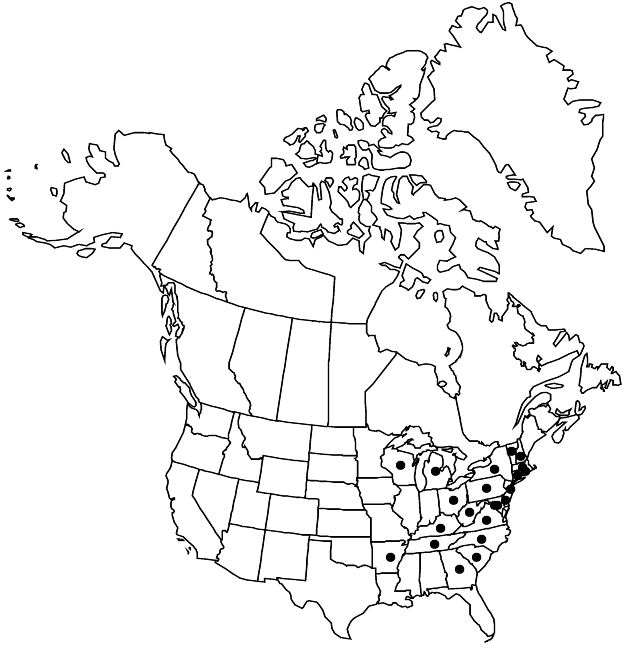Difference between revisions of "Ampelopsis glandulosa"
Bull. Univ. Mus. Univ. Tokyo 2: 78. 1971.
FNA>Volume Importer |
imported>Volume Importer |
||
| (6 intermediate revisions by 2 users not shown) | |||
| Line 12: | Line 12: | ||
|label=Introduced | |label=Introduced | ||
}} | }} | ||
| − | |basionyms={{Treatment/ID/ | + | |basionyms={{Treatment/ID/Basionym |
|name=Vitis glandulosa | |name=Vitis glandulosa | ||
| − | |authority=Wallich in W. Roxburgh | + | |authority=Wallich |
| + | |rank=species | ||
| + | |publication_title=in W. Roxburgh, Fl. Ind. | ||
| + | |publication_place=2: 479. 1824 | ||
}} | }} | ||
|synonyms={{Treatment/ID/Synonym | |synonyms={{Treatment/ID/Synonym | ||
|name=Ampelopsis brevipedunculata | |name=Ampelopsis brevipedunculata | ||
|authority=(Maximowicz) Trautvetter | |authority=(Maximowicz) Trautvetter | ||
| − | }}{{Treatment/ID/Synonym | + | |rank=species |
| + | }} {{Treatment/ID/Synonym | ||
|name=A. brevipedunculata var. citrulloides | |name=A. brevipedunculata var. citrulloides | ||
|authority=(Lebas) L. H. Bailey | |authority=(Lebas) L. H. Bailey | ||
| − | }}{{Treatment/ID/Synonym | + | |rank=variety |
| + | }} {{Treatment/ID/Synonym | ||
|name=A. brevipedunculata var. maximowiczii | |name=A. brevipedunculata var. maximowiczii | ||
|authority=(Regel) Rehder | |authority=(Regel) Rehder | ||
| − | }}{{Treatment/ID/Synonym | + | |rank=variety |
| + | }} {{Treatment/ID/Synonym | ||
|name=Cissus brevipedunculata | |name=Cissus brevipedunculata | ||
|authority=Maximowicz | |authority=Maximowicz | ||
| + | |rank=species | ||
}} | }} | ||
|hierarchy=Vitaceae;Ampelopsis;Ampelopsis glandulosa | |hierarchy=Vitaceae;Ampelopsis;Ampelopsis glandulosa | ||
| Line 43: | Line 50: | ||
|elevation=0–800 m. | |elevation=0–800 m. | ||
|distribution=Ark.;Conn.;Del.;D.C.;Ga.;Ky.;Md.;Mass.;Mich.;N.H.;N.J.;N.Y.;N.C.;Ohio;Pa.;R.I.;S.C.;Tenn.;Vt.;Va.;W.Va.;Wis.;Asia. | |distribution=Ark.;Conn.;Del.;D.C.;Ga.;Ky.;Md.;Mass.;Mich.;N.H.;N.J.;N.Y.;N.C.;Ohio;Pa.;R.I.;S.C.;Tenn.;Vt.;Va.;W.Va.;Wis.;Asia. | ||
| − | |discussion=<p>The infraspecific classification of Ampelopsis glandulosa is highly controversial. Five varieties were recognized by Chen Z. D. et al. (2007). A broad concept of this taxon is followed here.</p><!-- | + | |introduced=true |
| − | --><p>Native to eastern Asia, Ampelopsis glandulosa has become naturalized and weedy in the eastern United States. Reports from Alabama are based on plants persisting from cultivation; it does not appear to be naturalized there.</p><!-- | + | |discussion=<p>The infraspecific classification of <i>Ampelopsis glandulosa</i> is highly controversial. Five varieties were recognized by Chen Z. D. et al. (2007). A broad concept of this taxon is followed here.</p><!-- |
| − | --><p>This taxon was also known as Ampelopsis heterophylla (Thunberg) Siebold & Zuccarini, which is a later homonym (not Blume 1825; see Chen Z. D. et al. 2007).</p> | + | --><p>Native to eastern Asia, <i>Ampelopsis glandulosa</i> has become naturalized and weedy in the eastern United States. Reports from Alabama are based on plants persisting from cultivation; it does not appear to be naturalized there.</p><!-- |
| + | --><p>This taxon was also known as <i>Ampelopsis</i> heterophylla (Thunberg) Siebold & Zuccarini, which is a later homonym (not Blume 1825; see Chen Z. D. et al. 2007).</p> | ||
|tables= | |tables= | ||
|references= | |references= | ||
| Line 54: | Line 62: | ||
-->{{#Taxon: | -->{{#Taxon: | ||
name=Ampelopsis glandulosa | name=Ampelopsis glandulosa | ||
| − | |||
|authority=(Wallich) Momiyama | |authority=(Wallich) Momiyama | ||
|rank=species | |rank=species | ||
| Line 70: | Line 77: | ||
|publication year=1971 | |publication year=1971 | ||
|special status=Introduced | |special status=Introduced | ||
| − | |source xml=https:// | + | |source xml=https://bitbucket.org/aafc-mbb/fna-data-curation/src/2e0870ddd59836b60bcf96646a41e87ea5a5943a/coarse_grained_fna_xml/V12/V12_232.xml |
|genus=Ampelopsis | |genus=Ampelopsis | ||
|species=Ampelopsis glandulosa | |species=Ampelopsis glandulosa | ||
Latest revision as of 19:14, 5 November 2020
Lianas, low to moderately high climbing. Branchlets purplish green, usually sparsely puberulent, sometimes becoming glabrate. Leaves simple; petiole ± equaling blade; blade ovate, 6–14 × 4–11 cm, usually shallowly sometimes deeply, 3(–5)-lobed (but leaf never appearing compound), base cordate to subcordate, margins crenate-dentate to irregularly serrate, apex short acuminate, surfaces glabrous or abaxial surface puberulent. Inflorescences usually shorter than leaves. Flowers yellowish green. Berries ripening from green to white, rose, blue, or lilac, ± globose, 6–9 mm diam. 2n = 40.
Phenology: Flowering late May–Jul; fruiting Jul–Oct.
Habitat: Forest edges, pond margins, stream banks, thickets, disturbed areas.
Elevation: 0–800 m.
Distribution

Introduced; Ark., Conn., Del., D.C., Ga., Ky., Md., Mass., Mich., N.H., N.J., N.Y., N.C., Ohio, Pa., R.I., S.C., Tenn., Vt., Va., W.Va., Wis., Asia.
Discussion
The infraspecific classification of Ampelopsis glandulosa is highly controversial. Five varieties were recognized by Chen Z. D. et al. (2007). A broad concept of this taxon is followed here.
Native to eastern Asia, Ampelopsis glandulosa has become naturalized and weedy in the eastern United States. Reports from Alabama are based on plants persisting from cultivation; it does not appear to be naturalized there.
This taxon was also known as Ampelopsis heterophylla (Thunberg) Siebold & Zuccarini, which is a later homonym (not Blume 1825; see Chen Z. D. et al. 2007).
Selected References
None.